![]()
Part 2 -- Hannibal to Memphis, December 31 to January 3
Part 3 -- Memphis to New Orleans and Denver, January 4 to January 9
As Monica steers us toward Nebraska, Duncan uses a headlamp -- a gift from Uncle Ted and Loreen -- to read an Animorphs book. Tote's eyes track the isolated farm lights of eastern Colorado. Maggie is going to sleep -- something we know, because she announces it every minute or two. "Going to sleep" for Maggie appears to involve a lot of flopping about on the seat, a modicum of stretching her toes until she can poke Duncan, but not an iota of shut-eye.
In keeping with tradition, we left Denver four hours late. To add to the fun, I immediately made a clever navigating maneuver and ended up wandering around the airport's service roads rather than racing down the highway. No one seemed to mind the wrong turn too much. We've all been looking forward to getting started on our great adventure for so long that any sort of start was exhilarating.
This first leg -- from Denver to Chicago -- is not the most scenic. At Rand McNally, the fellows drawing the maps of Colorado and Alaska strut smugly around the office, while the wretches assigned to Nebraska and Iowa avoid eye contact with anyone at the office Christmas party. Though there aren't any mountains, we like looking out the windows. The muted colors have a subtle beauty, and it's interesting to keep an eye on the Platte River's meanders from the nearly straight highway.
There's no way to sugarcoat it: Fort Morgan stinks. The town has the invigorating aroma of six-day-old oysters. Duncan says that folks in Fort Morgan must spend a lot of time breathing through their mouths.
We debate the reason for Ft. Morgan's scent. Tote and Duncan blame the sugar beet factory. Monica insists it is the meatpacking plant. I think the horrible A&W we stopped at for dinner must be the source. The food was ghastly, but it was rivaled by the charm of the counter help. The poor woman was appalled, when she accused a young fellow of pinching a mug and it turned out the mug was still sitting on his table. To patch things up, she promptly accused him of pinching the newspaper he had tucked under his arm. Turned out the newspaper was the Los Angeles Times. She admitted that the Fort Morgan A&W did not currently subscribe to that particular publication.
Slipping softly past the battlements of Fort Cody, the largest fake-fort-souvenir stand in North Platte, Nebraska, Monica rounded up a room for us at the Stockman Inn. As we disembark in the parking lot, I realize no one is going to mistake us for stockmen. For one thing, our Toyota is the only foreign car in the parking lot. Not a

Honda or Isuzu in the place. For another, we may be the only folks in the county wearing Gore Tex and fleece. Thank goodness all the stockmen were well tucked in. If one had peeked out the window, he would have summoned the National Guard to repel the invading alien hoard.
The Stockman Inn is a great place. The room is clean, and before our children played "Skiffs" -- a game they created involving loads of bouncing and jumping about -- the beds were comfortable. The combination bellman, janitor, and maid is friendly, helpful and sporting a black Stetson. The Inn is one of two independently owned places in the whole town -- Fort Cody is the other. (Top)
The morning is damp and gray. It looks so grim that at 9:00 AM, Maggie asks, "Is it morning, yet?" Monica is undaunted; the sky reminds her of growing up in Illinois. "Yep, it was like this from November until March. Maybe see the sun twice," she proudly proclaims. The kids look at her strangely, as if they are thinking to themselves, "Why is she so happy about that -- sounds pretty darn miserable." I'm thinking to myself, "Great. We aren't going to see the sun for the next two weeks."
As we drive away from North Platte, we all stare in awe at the trees lining the River. Against the dull tans and browns of the rest of Nebraska, the river trees shine bright white, encrusted with frost. Apparently the freezing night and river fog worked together to produce this minor miracle.
After a moment of silence, Duncan tells Tote, "My side is a lot better than yours." He's right. While Duncan looks out at one of the prettiest sights I have ever seen, on Tote's side of the car is an enormous feedlot. Thank goodness it's cold enough to keep the windows closed.

We pass all sorts of interesting and thought-provoking things on the way to York, Nebraska. A military vehicle museum. The tiny Gothenburg Canal -- Panama Canal boosters, you have nothing to worry about. Signs advertising a giant bison made entirely from barbed wire.
Signs of the Bible Belt are everywhere. Giant crucifixes in prominent but odd places. Semitrailers bearing important messages from the trucking company, like "It's not a choice. It's a child" and a picture of a white, steepled church captioned "It's a good place to start the week."
Even Nebraska's highway engineers have the hereafter in mind. They've placed "rumble strips" -- corrugated segments of pavement designed to rouse sleeping drivers -- at critical places on the shoulder of the interstate. We notice that there's usually a set right before a bridge embankment. Obviously a good place to put them, but they typically start only about 20 yards before the embankment. At 75 mph, a sleeping driver probably has time to regain consciousness but not enough time to do anything constructive about the impending difficulty. We guess that Nebraska's highway engineers want to ensure that the soon-to-be crash victims are alert when they meet their maker.
The radio situation is also a bit bleak. Nearly every station features some lunatic who thinks that any sentence that does not contain the word JEEE-SUUS is a form of blasphemy. The only respite from these harangues is an ad exhorting us to get the "Husker Edge." The ad doesn't explain just what the "Husker Edge" might be but apparently it is something one can get by buying an official Nebraska Cornhuskers tablecloth or seatcover. The fellow on the ad cannot get through a sentence without the words "Nebraska Cornhusker."
Almost no foreign cars are in sight. The highway is filled with large, American-made cruisers. Oldsmobiles and Buicks seem to be at the top of the food chain but there are loads of Chevys and Fords. We are passed by a Mazda, but rapidly discover that it bears Colorado plates. We have entered the Land of American Cars.
Breakfast at the Legion Hall in York, Nebraska is great. The hostess, after triggering great merriment among the assembled crowd, by wishing a departing couple, "Happy Hanukah!" seats us at a table in the bar. Good-sized aisles separate us from the next table on one side and the bar on the other. Trouble is, good-sized is not Nebraska-sized. As soon as we are seated, a huge woman politely pushes past us on one side. Seconds later, a large gentleman starts down the aisle on the other side of the table. To be fair, the aisle is plenty big enough for him -- it's his stomach that forces the kids to jam themselves against the table edge. The procession continues for the entire meal. When a whole family departs simultaneously, squeezing past us on both sides, I consider climbing to the tabletop to escape trampling.
The food and the size of the people at the Legion Hall are a lesson in cause and effect. No one could routinely eat the spread here without gaining a couple hundred pounds. The buffet features corn beef hash, scalloped potatoes, various egg concoctions, waffles, hash browns, sausages, bacon, and an amazing innovation called a waffle boat -- a waffle in the shape of a dugout canoe. Instead of filling the inside of the canoe with dried berries and roots, one fills it with various kinds of pie filling and tops the whole thing off with whipped cream. All in all, there is nothing healthy served at the York Legion breakfast buffet. Yet everything tastes great, and it is impossible not to eat too much.
If the food at the York Legion Hall explains the size of the York Legionnaires, the size of the York Legionnaires may explain the penchant of Nebraskans for American cars. Most of the folks rumbling around the York Legion Hall couldn't fit into a Honda Accord even with the help of a forklift. "Honey the Chevy is starting to feel a bit tight around the hips, don't you think it's time we moved up to a Buick?"
After driving through an ice storm all the way to Omaha, we headed up to Ida Grove, Iowa to visit my great Aunt Helen. She stands tall and is as sharp as a tack. She remembers meeting Duncan in Storm Lake during Ragbrai 1988. He was  less than a year old then, and she was in her 70's. No one would ever guess that she is in her 80's now. When I was a kid, she would occasionally stop at Grandpa Dierks' house on holidays. She loves to play cards. Aunt Helen and her late husband Charles got hooked on card playing during the first years of their marriage. Aunt Helen explained that they were married in 1932, during the Great Depression. No one had any money, so they played cards and softball for recreation. "When we were first married, you could buy 3 pounds of hamburger for a quarter, and our rent was $10 a month." We are tempted to accept her invitation to spend the night, but we would like to get to Chicago tomorrow, so we climb back in the van. I would like to come back and spend a day playing cards.
less than a year old then, and she was in her 70's. No one would ever guess that she is in her 80's now. When I was a kid, she would occasionally stop at Grandpa Dierks' house on holidays. She loves to play cards. Aunt Helen and her late husband Charles got hooked on card playing during the first years of their marriage. Aunt Helen explained that they were married in 1932, during the Great Depression. No one had any money, so they played cards and softball for recreation. "When we were first married, you could buy 3 pounds of hamburger for a quarter, and our rent was $10 a month." We are tempted to accept her invitation to spend the night, but we would like to get to Chicago tomorrow, so we climb back in the van. I would like to come back and spend a day playing cards.
On the way to Des Moines, Maggie announces in a weary voice, "I'm going to sleep now. Wake me up when we get there. Okay?" After she repeats this four or five times, Duncan starts laughing. Monica and I figure Maggie will eventually run down. We are wrong. She is still going strong a couple hours later. "Wake me up, when we get there." Yet, when the rest of us disembark, Maggie is flopped on the seat, eyes closed and chin dangling. I pick her up, negotiate the outer door, slip her into our room, and touch her softly to the bed, when I see a smile begin around the corners of her mouth and turn itself into a laugh somewhere in the middle. Her eyes pop open and she announces, "Fooled you, Daddy!" And she had. (Top)
We know we're in "Chicagoland," when we notice a bumpersticker announcing, "I love being Polish." Before we reached the Broad Shouldered Stacker of Wheat, and most importantly, Grandma's house, we stopped in the Quad Cities for a quick tour.

We stopped for lunch at a tiny brewpub, The Front Street Brewery, in Davenport. We knew our server was someone special, when she said Tote had "acute perception." He had commented on the holiday decorations. Tote looked baffled. It turned out that Jenn, our server, was one of the owners. She explained a lot about Davenport to us. Although Davenport is now home to a riverboat casino, there aren't many signs of the promised economic boom. In 1882, Iowa passed a state prohibition amendment. Davenport's Koehler and Lange Brewery challenged the amendment on a technicality and won. Two years later, when the Iowa General Assembly strengthened existing temperance statutes, Mayor Ernst Glaussen announced that Davenport would not obey such an infringement on personal liberties. A local ordinance, passed in 1884, allowed the legal sale of a new variety of new beverages. Saloons continued to serve beer as "Mum," "Seafoam," "Cordial," "Hop Nectar," and "Kentucky Bluegrass."
The temperance movement and anti-temperance dodges are still alive. In 1989, the Illinois General Assembly outlawed happy hours. One of the provisions of the law forbids anyone to have more than one glass of liquor at one time. This screwed up the trade in boilermakers, until State officials decided that a shot and a beer was actually just one drink -- it's simply served in two glasses.
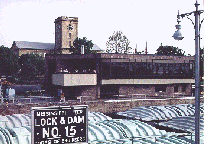
We also stopped at the Rock Island Arsenal and toured the Corps of Engineers Visitor's Center for Lock and Dam No. 15. The Lock isn't very active this time of year, but we learned several interesting things. In the interest of creating a shipping channel, the Corps of Engineers has converted the river into what is actually a series of lakes. All up and down the river are dams, accompanied by locks to let the barges through. The Mississippi "River" is really a chain of reservoirs or, in Corps terminology, "pools."
The first attempt at creating a shipping channel in the Mississippi did not come until after the Civil War, in 1878. That project had the very modest goal of creating a 4 1/2 foot deep channel. In 1907, Congress authorized work on a 6-foot channel. This was largely accomplished with wing dams made from rocks and willow mats. Despite these "improvements," by 1925 shipping on the Mississippi had nearly disappeared. According to a Corps of Engineers pamphlet, " a vessel larger than a pleasure launch or a fisherman's scow had become almost a curiosity." The demise of the Mississippi is relatively recent. Congress authorized the present system of permanent locks and dams in 1930 to create a 9-foot deep channel.
|
Aerial view of Lock and Dam 15 |
 It's hard to imagine that the huge barges plying the Mississippi have less than
a 9-foot draft. The amount of cargo that one barge tow -- a towboat and typically
15 barges -- can haul is pretty amazing. One tow can carry as much cargo as
870 semitrailers or 2 1/4 100-car trains -- roughly 22,500 tons. Usually these
barges carry petroleum, coal, or grain.
It's hard to imagine that the huge barges plying the Mississippi have less than
a 9-foot draft. The amount of cargo that one barge tow -- a towboat and typically
15 barges -- can haul is pretty amazing. One tow can carry as much cargo as
870 semitrailers or 2 1/4 100-car trains -- roughly 22,500 tons. Usually these
barges carry petroleum, coal, or grain.
Perhaps in response to the 1996 floods, the Corps has devoted a big chunk of the Visitor's Center to explaining why the Corps cannot control the River's flooding. The explanation makes some sense, but given that the Corps has justified any number of projects by pointing to flood control, something -- and it's not the River -- smells fishy.
We also stopped at Memorial Field. On one side of the field is a collection of cannons (one that could shoot 16 miles), anti-aircraft guns, prototype rocket launchers, and tanks. Here's what Maggie said:
I was climbing on the Army stuff. It was very cool. When I touch the metal stuff, my hands were getting cold. We got in the Army tanks. And I turned on all the cannons -- not for real.
Then we got in our car and drove to some graves. Then we counted all the graves and there were 2000 graves. They were there because people died in the Civil War. Daddy accidentally drove us right into where the Army people were living.
The Civil War cemetery is a bit mysterious. Rock Island was not the site of some great battle. The Confederate army never controlled more than the very southern tip of Illinois -- although in 1832 a young West Pointer, Robert E. Lee, had prepared a survey of the rapids at Rock Island for navigation improvements. Rock Island was the site of a Civil War prisoner of war camp, and Confederate prisoners are buried in the cemetery.

In light of the short time the Rock Island camp operated, the number of graves is stunning. Although the Civil War lasted about 4 years -- from April 12, 1861, when shots were fired at Fort Sumter, until Lee's surrender at Appomattox courthouse on April 9, 1865 -- for the first two years the two sides exchanged captives. The Rock Island camp operated only about 17 months, from December 1863 to April 1865 and housed 12,000 prisoners. Over 15% of the prisoners died; 1000 during the winter of 1863-64.
Barbaric as it sounds, the Union may have intentionally mistreated their Confederate prisoners. The Union's Secretary of War, Edwin Stanton, ordered retaliation against Confederate prisoners in response to conditions at the notorious Confederate prison, Andersonville. According to Encyclopedia Britannica, after the Union ended the prisoner exchange agreement in the summer of 1863, the large number of Union prisoners in Richmond, Virginia -- the Confederate capitol -- seriously pressed the food supply. In November 1863, the Confederacy started construction of a stockade in Andersonville, Georgia:
Pressure in Richmond led to prisoners being sent to Andersonville before barracks and other facilities were constructed. Drainage was poor and the water supply was inadequate. Prisoners received poor and uncooked food. Many were diseased and fatigued before arrival and disease was rampant in the prison . . . Nearly 13,000 prisoners died. After Sept. 1864 the prison was largely a hospital.
The Union used conditions at Andersonville as propaganda, although according to the Encyclopedia, "The Confederate government sought frequently but unsuccessfully to reinstitute an exchange of prisoners and offered to accept and administer any medical aid that the federal government might give; but this offer was rejected." Moreover, conditions at Rock Island sound as bad, if not worse, than those at Andersonville. According to a Corps of Engineers pamphlet:
The Civil War stockade was not finished when the first soldiers arrived in December. Lacking a hospital and medicine, the healthy and sick lived side by side during a record cold winter. By spring, disease had claimed 1,000 lives.
Andersonville, at least, had a hospital, and Georgia presumably had a milder winter. Nonetheless, after the war, the commander of Andersonville was tried by a military commission and hanged.
We were still an hour from Chicago, when the kids packed their backpacks. They wanted to be ready to leap from the van and race into Grandma and Grandpa's house without wasting any time. And as soon as I stopped the car, they were out of the car and into the arms of their grandparents. (Top)
The highlight of the day was ice skating at the Elmhurst YMCA. No one except Grandma was very steady. I managed to stay upright, though my progress around the rink was accompanied by so much twitching and jerking that I looked as if I were suffering from St. Vitus's dance. Maggie offered all sorts of sage advice like "Don't look down, just feel your feet" and "Stay away from the side, because it goofs up your balance." Before the end of the day, Maggie and Tote managed to skate around the rink without help. (Top)



We spent most of the day in the Hyde Park neighborhood on the south side of Chicago. Our first stop was Promontory Point, a park perched on an outcropping of land at the end of 54th Street. The kids were reluctant explorers, until they saw huge waves crashing into the breakwaters. In short order, Duncan and Tote were laughing and romping in the spray.
Maggie and I explored the restored park building at the end of the point. The limestone building sported a tower with a winding stairway to the top, so we climbed it. This is what Maggie saw: "We saw my mommy -- just a little red girl. It was a tiny scary, but I liked it. My brothers didn't come with me, my daddy did. I liked the waves -- they were crashing."
When David Rubin last visited us, he started reading The Golden Compass, a fantasy novel, to the children. It opens with the adventures of a young girl named Lyra at Jordan College. Jordan is a medieval version of Oxford, featuring chapels, scholars, gargoyles, and run by a Master.The University of Chicago -- filled with stone carvings, leaded glass, odd libraries, and an assortment of chapels -- looked just as we imagined Jordan. We poked around odd nooks and crannies, peering out at the rainy, gray day from odd balconies and in at the majestic, undergraduate libraries. As Duncan says: "We went out on this balcony and there were these battlements and we were looking out. You could see the ground way down. There were lots of books in the library, even some in Greek." Maggie remembers: "Daddy showed me a special secret -- silly gargoyles. They looked as funny as funny can be. They were right by a black gate. They were crawling up the top of a gate thing." (Top)
When we fell asleep one time, I heard strange noises because Tote was awake because Tote was playing with the storm trooper. But I kept falling asleep because I thought it was nighttime. Tote came in our room and said wake up wake up. Then we looked in our stocking which were clean socks. And we gave something to Santa -- and then we were looking for our presents. Santa left a note for us.
Tote says:
My favorite present was a Ronto and Jawa set. We had a big dinner with a lot of people: Justin, Jonathon, Aunt Peggy, Uncle Todd, my family, Uncle Dave, Joyce, Jenny, Brien, Jerry, Marilyn, Grandpa, and Grandma. We played a big Star Wars game. It was an imaginary game. We played with Justin, Jonathon, and Duncan. Duncan and Justin were emperors; I was a lord; and Jonathon Hughes was an admiral. We played all over the house.
Uncle Dave says:
It was really great to see the Denver AND Springfield Hughes families. I also received some nice presents! Maggie wants to be an astronaut when she grows up; maybe in the space hotel floating around Earth. Tote will live on one of Saturn's moons. (Top)
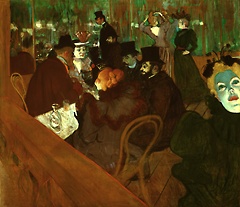
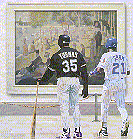 The
Art Institute of Chicago remains one of the very best museums in the world.
It is hard to imagine a better place to learn about western painting, so that's
what we did. Toulouse-Lautrec, Matisse, Van Gogh, Renoir, and Picasso were the
subjects of the day, with a tad of Monet thrown in for good measure. Tote immediately
focussed on Lautrec's odd composition -- the huge railing in the foreground
of one picture and the disembodied arms of a conductor in another. After a bit,
Duncan was picking out Matisses from across the room, based on Matisse's fascination
with pattern and thin application of color.
The
Art Institute of Chicago remains one of the very best museums in the world.
It is hard to imagine a better place to learn about western painting, so that's
what we did. Toulouse-Lautrec, Matisse, Van Gogh, Renoir, and Picasso were the
subjects of the day, with a tad of Monet thrown in for good measure. Tote immediately
focussed on Lautrec's odd composition -- the huge railing in the foreground
of one picture and the disembodied arms of a conductor in another. After a bit,
Duncan was picking out Matisses from across the room, based on Matisse's fascination
with pattern and thin application of color.
To my utter amazement, while were checking out the Barrett Collection, Duncan grabbed my arm to show me his favorite painting -- a landscape by Gustav Hodler. Hodler is a pretty obscure Swiss artist. It has been my favorite painting for a very long time. (Top)
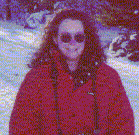 When I was growing up, Jerry Sheahan -- a friend of my father's -- bought ten acres of land near McHenry, Illinois. The ten acres contained several hills and a grand old oak tree, but a large part of the parcel was wetland. For a long time, until Jerry hired a fellow to dig a pond, a hummock-studded swamp ran through the middle. Looking back on what the place used to look like, it is hard for me to understand just how much I loved the place. And I did love it.
When I was growing up, Jerry Sheahan -- a friend of my father's -- bought ten acres of land near McHenry, Illinois. The ten acres contained several hills and a grand old oak tree, but a large part of the parcel was wetland. For a long time, until Jerry hired a fellow to dig a pond, a hummock-studded swamp ran through the middle. Looking back on what the place used to look like, it is hard for me to understand just how much I loved the place. And I did love it.
I loved the "Ten Acres," because it was our place. We climbed trees. We built trails with axes and saws. Once we built a tower. I don't know how tall our tower actually was, but in my memory it towers above even the great oak tree. We didn't know that best way to build a tower is on the ground -- sideways -- and then hoist the whole thing upright. We put four tall uprights in holes first and then shinnied up them to tie on the crossbeams. Lashing the top pieces in place, leaning into space and supported only by my legs wrapped around an upright, was scary but stupendously exciting. We planted hundreds of trees, careened down the hills on every conceivable conveyance from wagons to sleds, and roasted hot dogs, marshmallows, and toes around innumerable campfires.
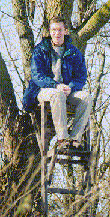 I also loved the "Ten Acres," because Jerry was there. Jerry encouraged every lunatic idea that might pop into the head of someone too young to know any better -- and came up with a few humdingers of his own. On trips with Jerry, we invariably returned wet, cold, muddy, frozen, blistered, burned, bleeding or some combination that would lead my mother, as soon as she laid eyes on us, to shout, "Don't come inside yet! Don't come inside yet! Take those clothes off right there!" We quickly learned that anytime we took a trip with Jerry, it was wise to bring along an extra set of clothes.
I also loved the "Ten Acres," because Jerry was there. Jerry encouraged every lunatic idea that might pop into the head of someone too young to know any better -- and came up with a few humdingers of his own. On trips with Jerry, we invariably returned wet, cold, muddy, frozen, blistered, burned, bleeding or some combination that would lead my mother, as soon as she laid eyes on us, to shout, "Don't come inside yet! Don't come inside yet! Take those clothes off right there!" We quickly learned that anytime we took a trip with Jerry, it was wise to bring along an extra set of clothes.
If we climbed a tree, until we were so high our own parents blanched, Jerry would encourage us to go higher or out on an even more slender limb. Our Scout leaders insisted we build only small campfires. Small fires were better for cooking. They didn't scorch your face -- or your tent. The Indians, although they never learned the Scout Oath, were to us Scouts the ultimate touchstones of camping efficiency and our Scout leaders assured us that they had never built anything but tiny fires. Jerry, on the other hand, did not consider a fire a real campfire, unless it could be seen from space. At the "Ten Acres," when Jerry started a fire, he typically doused everything in sight with lighter fluid and tossed a match in it. Scorched eyebrows, temporary blindness, and shock were nothing compared with the delight of witnessing an adult doing everything so delightfully wrong. Under Jerry's tutelage, we learned never to pass a pond or creek without attempting a dip -- with or without a swimsuit. We discovered that cattails won't burn, though they look as if they should. (Jerry discovered that cattails burn like crazy once soaked in kerosene.) We caught every kind of beast, and occasionally built snares to trap our unsuspecting brothers. We learned the rudiments of sailing, breaking only one mast. We learned how to plant a hundred trees in a single day. We had mud fights, water fights, grass fights, torch fights, and flaming marshmallow fights.
 It would be easy to say, as Jerry sometimes does, that Jerry was the biggest kid of all, but that really wasn't true. All our adventures took place against a background of Jerry's fundamental refrains about life. We learned that we really could do more than we thought we could -- that we could do absolutely incredible things. We learned that we either had to solve our own problems or live with them, and we learned that none of those problems were as serious as they seemed. We learned that daring to do something was nearly as important -- maybe more important -- than succeeding. We learned to feel competent and confident and to trust ourselves. Whenever I returned from the "Ten Acres," usually after dozing in the cozy, leather backseat of one of Jerry's ancient Lincoln Continentals, I felt I could do anything I set out to do.
It would be easy to say, as Jerry sometimes does, that Jerry was the biggest kid of all, but that really wasn't true. All our adventures took place against a background of Jerry's fundamental refrains about life. We learned that we really could do more than we thought we could -- that we could do absolutely incredible things. We learned that we either had to solve our own problems or live with them, and we learned that none of those problems were as serious as they seemed. We learned that daring to do something was nearly as important -- maybe more important -- than succeeding. We learned to feel competent and confident and to trust ourselves. Whenever I returned from the "Ten Acres," usually after dozing in the cozy, leather backseat of one of Jerry's ancient Lincoln Continentals, I felt I could do anything I set out to do.
It was reassuring to see that our kids loved the "Ten Acres," too. While Jerry tried to organize a hike through a stand of trees -- trees that I helped plant -- Duncan, Tote, and Maggie made a beeline for the top of another hill. Jerry remarked "Boy, they seem pretty at home, here." What did he expect?
Here's what Jerry said about our visit:
Mark wanted to show his kids the pond and 10 acres in Bull Valley that meant so much to him as a kid -- so we went on a cold (26°) but sunny afternoon with snow on the ground.
The country was really bright and beautiful with clumps of snow hanging like white ornaments on the bare branches. I got to lead hikes past my newly refound bald cypress, and white pines that Mark planted in 1971-72 and are now 40 feet tall! That was exciting at least to Mark and me. We sat around a bonfire and had hot dogs etc. as darkness came. Brien and Jenny came up too, and Jenny's friend, so we had a really nice time.(Top)
The best gifts are ones that unexpectedly interest you. Someone opens these and says "Why would they get me this?" and then a day or two later says, "That was a great gift!"
This year, Ted gave Dave an abacus. In the unpacking, Dave pretty much overlooked the thing, but by the end of a couple days, everyone had spent some time urging people to "give me some numbers," so they could try their skill on the abacus. Everyone, that is, except mom and Monica. Those two were just too busy with the Christmas commotion.
Today, we packed and were ready to leave Elmhurst, but we really weren't ready to go until afternoon. Instead of heading to Nauvoo in the dark, we decided to stay in Elmhurst to spend a last day with Grandma and Grandpa. This gave Monica and Grandma the chance they were waiting for. They spent most of the evening playing with the abacus.
Monica and mom took abacus calculation to new levels -- or at least to levels not seen around the Hughes house. They started with the standard stuff -- addition and subtraction -- but as midnight neared, they discovered how to multiply three digit numbers by three digit numbers. Soon their results were running to six figures, and they were chattering away finding ways to reduce the bead flipping required to reach an answer.
The key to Mom and Monica's success was their early discovery that multiplying by any power of ten is simple, and the abacus is quite capable of adding those results. So, multiplying 356 by 234 means adding 35600 to 35600, then adding 3560 three times, and 356 four times. That's nine additions and no multiplications. Doing the problem the standard way with pencil and paper takes nine multiplications and one addition.
The abacus works amazingly well. Although we associate the abacus with Asian cultures, it was used all over Europe and in northern Africa, too. The word "abacus" probably comes from the Phoenician abak, describing sand spread on a surface for writing. Without something like an abacus, how could the Romans have added all those Roman numerals together? Although we no longer use Roman numerals, even an inexperienced abacus user can add and subtract columns of lengthy arabic numbers faster than most folks can do the same problems with pencil and paper. This may explain why the abacus remained in common use in western countries until into the 1600s. According to our trusty Brittanica:
[The abacus] gradually was abandoned as the Arabic notation of nine figures and zero replaced the Roman numeral system in calculating. The abacus was last generally used in Spain and Italy in the 15th century, in France in the 16th century and in England and Germany in the 17th century.
Duncan says, "I'd like to tell everyone at school that on the way home from Chicago we stopped in Peru." So, we did. We stopped for lunch at the Peru Pizza House in Peru, Illinois.
Unknown to our trusty Brittanica, Peru is home to the Abacus Tax Service -- we didn't stop to see whether they actually used them or, if they did not, to show them how great they are -- and Maud Powell. Maud Powell, a violinist, was the first U.S. musician to achieve international recognition. A statue in downtown Peru commemorates her success. The statue is nice; it even plays violin music. (Really!)
From Peru on down to the Mississippi we are tracing the path of French explorers, Marquette and Joliet, but in reverse. Louis XIV sent Louis Joliet, who had explored Lake Erie, and the Jesuit Father Jacques Marquette to investigate the Mississippi. After their brief exploration of the Mississippi River in 1673, the pair headed up the Illinois River -- the river we are travelling down -- and back toward Chicago.
Dickson Mounds State Park contains a collection of ancient burial mounds. Today, it is a great place to get a glimpse of how briefly Europeans, and even most modern Native American tribes, have occupied North America. Since 12,000 BC, man has inhabited the Illinois River valley. Archeologists identify four different cultural groups during this period: Paleolithic, Archaic, Woodland, and Mississipian. Apparently, most of the work at Dickson Mounds concerned the last group.
Dickson was near the northern end of a collection of Mississippian villages that extended south to the Gulf and from Florida to Oklahoma. The objects displayed at the museum resemble Aztec or Mayan or Olmec objects more than things typically associated with North American Indians. The village typically consisted of a central courtyard that contained a few earthen mounds topped by a chief's house or a temple. A stockade surrounded the villages. The whole shebang disappeared around 1500.
These Mississippian folks were no slouches. At Cahokia Mounds, near the confluence of the Illinois and the Mississippi, they built a city with a population of 20,000 souls. Occupied from 700 to 1500 AD, for most of that time it was larger than London. No city in Illinois reached that size again until the mid-1800s.
The museum does two things very well. First, it has a great kids area. There are loads of activities for children, stored away in a large collection of sliding drawers. For the most part, these things are well conceived and downright fun. There is also a hands-on model of a Mississippian village. Duncan, Tote, and Maggie spent a long time rearranging houses, fires, burial mounds, and other essential parts of a Mississippian village.
Second, the exhibits really put the different cultures into an historical context. In particular, a timeline traces the different cultures that used the Dickson site. Beneath the timeline are potsherds, arrows, and other artifacts. Above the local timeline is a narrative describing what was going on with other cultures in North America. The exhibits also refer to time periods in terms of human generations -- not necessarily precise but nonetheless, a good way of connecting visitors with past peoples and giving them a better handle on the vast time periods involved.
Unfortunately, the museum has some strange shortcomings. First, the museum seems very disconnected from what was actually found at the site. The artifacts on display, with exception of two long cedar sticks, could easily fit in a single shopping bag. It is difficult to tell what was actually found onsite and what is imported. There were pictures of Powhaten's charnel house in Virginia and dances in Natchez. Nothing explained how these things related to Dickson Mounds or Mississippian culture. Nothing showed what was actually found at Dickson. Nothing explained whether anything found at Dickson was significant.
Second, parts of the museum seemed to take some unexplained leaps regarding Mississippian culture. There is a bizarre, boring, and incredibly creepy multimedia presentation about the cosmology and religion of these folks. The show takes place in a large dark room. Visitors stand on ramps along the edges, separated by a four-foot wall topped by handrails from a large flat area in the center. In the corners of this large flat area are several particularly unrealistic mannequins Indians. Strips of cloth or plastic hanging from the ceiling surround these counterfeit Indians -- a scene reminiscent of a cheesy sci-fi movie,. White sheets cover the flat area in the center. During the show, these sheets billow slightly, like shrouds or ghosts in a nightmare. The sheets serve as a projection screen, but since they are on the other side of the wall, one must look down to see the things.
Strange as the theater is, the show is worse. Dramatic lighting, creepy noises, and a meaningless script provide a haunted house atmosphere but little more. A brief blurb on a sign outside explains the show is based on extrapolations from artifacts found at the site and beliefs of American Indians.
On the way out, amidst a display of old promotional literature, there are a few brochures of what was formerly at Dickson Mounds. On the cover of two, there are photos showing the excavation on which the museum sits. They show visitors standing around the edges of a large room, separated by a four-foot wall topped by handrails from an open area in the center. Instead of viewing a scary multimedia mess, the visitors are looking into an excavation of one of the mounds.
Later we are told that the excavation was covered up and turned into a theater. Illinois closed the excavation and removed all photos of it to quell Native American protests. This explains the weird theater. Yet it makes the creepy show even creepier. Snickering school trips can now stand in the dark only feet from where a whole bunch of dead people is buried.
As we near Macomb, we see billboards praising "Technology That Yields" and bearing the slogan "Weigh Beyond Anything" -- advertisements for corn seeds. We also learn that Macomb is an "Illinois Certified City," whatever that means. (Top)
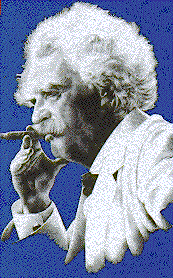 Everything
in Hannibal seems to smell like some weird combination of Windex and chlorine.
There must be some crazed Amway salesman pumping cleaning fluid into every building
in town. Currently, we are imprisoned in the Best Western in "downtown" Hannibal.
Our room reeks of disinfectant. We'd open the windows to get some fresh air,
if they opened. We'd open the door, but it opens on the section of the lobby
that contains the swimming pool.
Everything
in Hannibal seems to smell like some weird combination of Windex and chlorine.
There must be some crazed Amway salesman pumping cleaning fluid into every building
in town. Currently, we are imprisoned in the Best Western in "downtown" Hannibal.
Our room reeks of disinfectant. We'd open the windows to get some fresh air,
if they opened. We'd open the door, but it opens on the section of the lobby
that contains the swimming pool.
Someday I would like to speak to the moron who thought people would like to stay in a hotel that smells like a YMCA locker room. The hotel's brochure says the pool is "situated in lovely Palm Tree setting." It is actually located in the lobby. Maybe there is a "lovely Palm Tree setting" in some other Best Western. This one has only three dusty plastic palm trees flanked by a couple fake bamboo plants.
I'm not complaining about the absence of palm trees. I don't believe any living thing deserves to be tortured. No living thing, save perhaps an eyeless cave fish, could survive very long in the nightmarish half-light of the lobby. Even if it could, the air would kill it. Normal air contains mainly nitrogen and oxygen. The Best Western has replaced both with chlorine.
On the other side of the lobby is a bizarre concoction of plastic that may be a 1960's vintage piece of hotel art, but looks more like a Chinese lantern in a crummy bar. This, according to the brochure, is "a lighted bubbling fantasia/water fountain." The effect is heightened by the fake Bird of Paradise flowers around the "fantasia's" base.
Across the street from this future Superfund site is the "Mark Twain Dinette and Drive-In Inc." To reduce the time we spent breathing the hotel's air, we ventured to the Dinette for dinner. The Dinette's doors are adorned with pictures of Samuel Clemens that, if accurate, would conclusively establish that Mr. Clemens was in fact a sea slug. Since the aroma of potato flakes and disinfectant was not the atmosphere we sought for dinner, we headed elsewhere.
 Leaving the Dinette was a mistake. After 8:00 PM, there is no other place to eat dinner in downtown Hannibal. The bright side is that at least in Hannibal there are sidewalks. So many of the places we have visited no longer have hotels near their city centers. This means one is typically stranded in the middle of some car-dominated landscape.
Leaving the Dinette was a mistake. After 8:00 PM, there is no other place to eat dinner in downtown Hannibal. The bright side is that at least in Hannibal there are sidewalks. So many of the places we have visited no longer have hotels near their city centers. This means one is typically stranded in the middle of some car-dominated landscape.
In keeping with Duncan's desire to relate an exotic itinerary to his school chums, we arrived in Hannibal after passing by Vermont, Estes Park, Warsaw, Denver, and Carthage.
Denver, Illinois is worth a mention, because it provides a wonderful lesson in political science. The History of Hancock County published in 1968 notes:
Denver has never been incorporated, the citizens being content with township and county government. We are proud of the fact that there has never been a saloon or tavern in the town, and that is why no doubt that they have never needed more government.
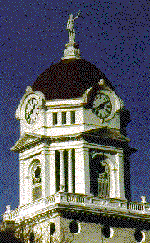
Denver is just south of Carthage, Illinois. Carthage is the county seat of Hancock County. In the first case tried in an earlier version of the current county courthouse, Abraham Lincoln defended a gentleman charged with murder after a drunken brawl. His client is the only person ever legally executed by hanging in Hancock County.
Joseph Smith, the founder of the Mormon Church, and his brother Hyrum Smith were also killed in Hancock County but without benefit of trial. We visited the Old Carthage Jail, where although the two were in custody, a mob attacked and shot them to death.
Carthage and Nauvoo -- which we visited later in the day -- are places where Americans committed truly atrocious acts against other citizens, because those citizens held different religious beliefs. There is no way to reconcile the murder of Smith or the forced abandonment of Nauvoo with our nation's supposed dedication to religious tolerance.
Yet it is hard to work up a good case of righteous outrage, because the Mormons themselves don't seem outraged. Perhaps the most curious thing about how the Mormons present the sites is the absence of any overt mention of religious persecution. Smith is never called a martyr. The Constitutional guarantee of religious freedom is never mentioned. We heard the phrase "religious persecution" only once during our tours.
Perhaps the omission is explained by one Mormon Trail diary entry, actually concerning the trials of the Mormon Trail: "Notwithstanding our suffering, hardships and privations, we are cheerful and rejoice that we have the privilege of passing through tribulations for truth's sake."
Whatever the reason for the omission, it leaves weird gaps in the presentations at Carthage and Nauvoo. The obvious question at Carthage is: "Why was the mob so angry?" At Nauvoo; "Why would tens of thousands of people, who apparently had a flourishing city and must have outnumbered any neighbors, pack up and leave?" Perhaps the answers to these questions are obvious or the stories are so familiar to Mormons that there is no need to repeat them. Or maybe the answers don't reflect well on church founders or doctrine, and the omissions are a way of sugarcoating the whole thing.
The Mormon Church now owns the Carthage jail site and runs a small visitor's center and tours. The tour and a movie at the center emphasize Smith's good deeds and Christian preaching. The movie shows Smith translating the golden plates containing the Book of Mormon. It also shows many glimpses of the Nauvoo Temple.
The Carthage mob was not the first group pissed off at the Mormons. The movie shows Smith and other Mormons in custody in Ohio, before coming to Illinois, and quotes Missouri Governor Lilburn Boggs's October 30, 1838 order that "the Mormons must be treated as enemies and must be exterminated or driven from the state, if necessary, for the public good." The movie does not relate that following Boggs's order seventeen Mormons were killed and many others wounded. It also doesn't say a word about why Smith was in custody or drew Boggs's ire.
The National Park Service brochure on the Mormon Trail lists a number of things that angered Nauvoo's neighbors:
Hostility, fear, and controversy . . . surrounded the church. The rapid growth of church membership, the financial success of the members and their church, religious beliefs that were outside mainstream Christian tradition, the practice of plural marriage (polygamy), a large well-armed militia, the blurring of lines between church and state, and the perception by some non-Mormons that the church was a threat all fueled intolerance.
The Mormon Church was growing rapidly. Although Smith started the Mormon Church in 1830, by the early 1840s the Mormons had built what Britannica (and one of the Mormon elders at the Carthage jail) says was the largest city in Illinois, with a population of about 20,000. (The Nauvoo Visitor's Center says Nauvoo's population always lagged behind Chicago's and peaked at 11,500 in 1845.)
Having thousands of followers also meant having control of thousands of votes. This political clout initially helped -- but ultimately hurt -- the Mormons. According to T.C. Pease in The Story of Illinois, "From the beginning Smith . . . sought to trade off the thousands of votes he controlled for political privileges." Britannica says:
With increasing church population, the political question again became an issue, with the [Mormons] holding the balance of power between the Whigs and the Democrats in Illinois and being alternately courted by both parties. While this possession of the balance of power at elections appeared momentarily advantageous to the Mormons, in the end it proved disastrous; it alienated all parties, since none could rely upon their allegiance.
Another source of friction was Nauvoo's militia. There is no dispute that the Nauvoo Legion was very large. What role the Nauvoo Legion played in Nauvoo is unclear -- Nauvoo had a separate police force -- but the Nauvoo visitor's center displayed a pamphlet containing the ordinances of the City of Nauvoo and of the Nauvoo Legion. The typefaces on the cover are interesting. "Nauvoo Legion" is printed about twice as large as the city of "Nauvoo." (The printer listed on the cover is Joseph Smith, Jr.).
According to our guide at Carthage, Nauvoo's relative independence from Illinois's political institutions was also a problem. To secure Mormon support for the presidential election of 1840, the Illinois legislature granted Nauvoo a liberal city charter. Thomas Ford, elected Governor of Illinois in 1842, declared that through the charter:
[I]t was proposed to reestablish for the Mormons a government within a government, a legislature with powers to pass ordinances at war with the laws of the state; courts to execute them with but little dependence upon the constitutional judiciary; and a military force at their command, to be governed by its by-laws and ordinances and subject to no state authority but that of the governor. . . . The great law of the separation of powers was wholly disregarded. The mayor [Joseph Smith] was at once the executive power, the judiciary, and part of the legislature.
|
"Reason" - a site with a generally negative view of Mormonism, relying mainly on historical documents "All About Mormons" - a very complete site for generally positive information on Mormonism Mormon Trail information by Elkhorn Middle School |
Although our Mormon guide at Carthage agreed that Nauvoo's charter gave the city unique independence, the Nauvoo visitor's center relates that Nauvoo's charter was similar to that of other cities in Illinois.
Compounding, or perhaps central to, Nauvoo's problems with its neighbors was the Mormon practice of polygamy. In 1843 Joseph Smith dictated a lengthy revelation on marriage. This revelation also taught that, when god commanded it, a man might have more than one wife. Apparently, some of the patriarchs and prophets of the old testament were polygamists.
Smith -- no dummy -- knew that revealing that god had authorized polygamy had the potential to divide the church, increase hostility from outsiders, and disrupt his own family. Emma, though she had faith in Smith's prophetic calling, never could reconcile herself to this particular revelation. In fact, the Reorganized folks teach that it was Brigham Young, not Smith, who came up with the Mormon endorsement of polygamy and falsely attributed it to Smith.
Some of Smith's close confidants said that he introduced polygamy in Nauvoo only after personal struggle and divine warning. Lorenzo Snow remembered an 1843 conversation with Smith about Smith's "repugnance of his feelings" about polygamy:
He knew the voice of God-he knew the commandment of the Almighty to him was to go forward-to set the example, and establish Celestial plural marriage. He knew that he had not only his own prejudices and pre-possessions to combat and to overcome, but those of the whole Christian world...; but God...had given the commandment.
The Biography and Family Record of Lorenzo Snow, pp. 69-70 (Salt Lake City, 1884). Smith proceeded only after an angel declared that Smith must introduce polygamy, or god would replace him with another prophet.
It is worth noting that in October 1890, Mormon President Wilford Woodruff announced an official end to new plural marriages. In 1904, President Joseph F. Smith announced that it would be Church policy to excommunicate any member either practicing or openly advocating the practice of polygamy. Despite these edicts, members of some Mormon fundamentalist groups still practice polygamy but outside the mainstream Mormon Church.
Smith also had a press problem. Although the visitor's center displays a favorable comment about Smith and Nauvoo from the New York Times, Smith had big problems with the local press. Smith landed in Carthage jail in large part for his response to the first and only issue of the Nauvoo Expositor, a paper directed by excommunicated Mormons.
When Smith suppressed the Expositor, he set in motion the events that led to his murder. According to Britannica:
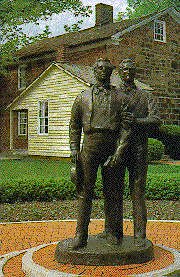
Threats of mob violence followed, and the prophet, as lieutenant general of the Nauvoo legion, in order to protect the city, called out the troops. For this he was charged with treason and with others, including his brother Hyrum, was incarcerated in Carthage jail under pledge of protection by Governor Ford. This pledge was not kept. On the afternoon of June 27, 1844, a mob of armed men with blackened faces assaulted the jail and murdered Joseph and Hyrum Smith.
After Smith's murder, Brigham Young became the leader of the main body of the Mormons. Young received a message from God telling the Mormons to head to what is now Salt Lake City -- at that time, it was unsettled Mexican territory. In the winter of 1945-46, they did.
Historian T.C. Pease notes that Illinois just did not have institutions capable of coping with the Mormons:
Much may justly be said in condemnation of the violence that drove the Mormons out of the state at the point of the rifle; much more of the murder of the Smiths. But it must not be forgotten that the Mormon community was growing with frightening rapidity and that it had fastened itself in a body politic so rudimentary that it could not itself expel the intruder. Smith had striven to set his community outside the law of the state; by political bargaining, he had nearly accomplished it. The state had no police force adequate to deal with the menace of autocratic government and defiance of law and morals at Nauvoo. The frontiersmen took the law in their own hands when the simple government they had erected in the state for their simple needs proved inadequate. In the frontier stage that was passing in the forties, action was taken that in the more advanced state of a decade later would not have been condoned.
T.C. Pease, The Story of Illinois, at 130-31.
Before departing, the Mormons completed the Nauvoo temple -- a grand structure on the highest point in town. God had ordered up this magnificent structure during Smith's life. According to our guide at the visitor's center, the finishing touches were added to the temple while the wagons were lined up on Parley Street, ready to head west. (The temple was later sold to the Icarians, a group of French communitarians who arrived shortly after most of the Mormons departed.)
Apparently Young's ascension to leadership was not automatic. Emma Smith, Joseph's wife, did not think Brigham Young should lead the church, and with many others, she stayed behind. According to one of our guides, Emma wanted her son -- Joseph Smith III, then 11 -- to run the show. Eventually, this split led to the creation of the Reorganized Mormon Church. Joseph Smith III spent most of his time attempting to prove that his father had never practiced or encouraged polygamy and trying to suppress polygamy in the Mormon Church in Utah.
The split has resulted in an odd sort of cold war in Nauvoo. The Reorganized folks have their a separate visitor's center and own Smith's grave. The Salt Lake City Mormons have a fancier visitor's center and have restored about 20 buildings.
It is worth wondering whether the prospect of a long running internecine battle with Joseph Smith's widow may have helped Brigham hear God's relocation notice. With the largest militia in Illinois, the second largest population in the State, uniform discipline, and common leadership, Nauvoo would not appear to have been an easy target for its neighbors. It is hard to understand how Nauvoo's neighbors could actually have forced the Mormons out, although a
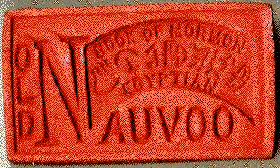
National Park Service brochure on the Mormon Trail notes that in September 1944, "foes burned more than 200 Mormon homes and farm buildings outside Nauvoo in an attempt to force the Mormons to leave." It is also worth asking, if their foes posed a real threat, how Smith's widow could have safely remained in Nauvoo, raising a successor to Smith. Maybe the answer is simply that the Mormons genuinely believed that Brigham Young was getting direct word from on high.
Other groups headed off in different directions after Smith's death. The Strangites were one of the most interesting. After Smith's murder, Jesse James Strang came up with a letter, supposedly written by Smith, designating Strang his successor. (In 1981, someone discovered a letter saying that Smith intended for his own son to take over as leader.) Young denounced Strang as an impostor and forger and booted him from the church. Strang clearly knew the ropes of the prophet business. According to Britannica, after losing his battle with Young:
Strang persuaded a group of his own followers, including Smith's brother William, to move to Voree, Wis. (near Burlington), where they organized the new sect. There in 1845 he allegedly translated (with the aid of magic spectacles given him by an angel) The Book of the Law of the Lord from golden plates from the Ark of the Covenant. Strang then established a secret society that swore allegiance to him and operated under puritanical rules.
Dissension prompted Strang to relocate the colony in 1847 to Beaver Island, in northern Lake Michigan. By 1849 the city of St. James was established on the island's northern coast. The following year Strang received another revelation in the "plates of Laban." It sanctioned polygyny, and he was married to four wives at one time. He also claimed that it sanctioned his coronation, and in July he became King James I. The Strangites endured considerable persecution, but Strang was able to preserve the sect and to gain acquittal in the several lawsuits brought against him.
Twice elected to the legislature in Michigan (1852, 1854), Strang had more than 5,000 followers when he was shot on June 16, 1856, by two former Strangites. Though he knew death was near, he refused to appoint a successor. Lake Michigan fishermen subsequently drove more than 2,000 Strangites from their homes and all but extinguished the sect.
Visiting Nauvoo is genuinely fun. Mormon missionaries run all the restored building and the visitor's center. Unlike the pairs of white-shirted young men who ride mountain bikes around town, these Mormon missionaries are charming couples with an average age of about 60. They dress in period costumes and lecture about the buildings and former inhabitants. Though they are not rocket scientists, they were uniformly charming and helpful. (They were so charming that I couldn't bring myself to ask any of them about polygamy.) (Top)
Part 2 -- Hannibal to Memphis, December 31 to January 3